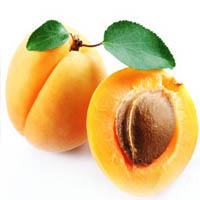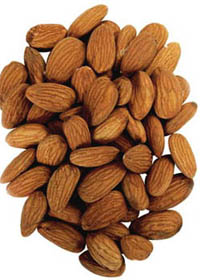

Hydrocyanic acid
Hydrocyanic acid HCN is a colorless volatile liquid (T boil.=26 °C) with the smell of bitter almonds, it is mixed with water. Hydrocyanic acid is defined in the air already at a concentration of 2-5 mg/m3. In nature it occurs in the seeds of some fruits in the form of amygdalin is a derivative (glycoside) of the carbohydrate gentiobiose (C12H22O11) and benzaldehyde. Almond contains 5-8% of amygdalin, in the seeds of peaches, plums and apricots from 4 to 6 %. During the hydrolysis of amygdalin (with the action of acids or enzymes) hydrocyanic acid is in free form. Small amounts of hydrogen cyanide is contained in coke oven gas and in tobacco smoke.
Hydrocyanic acid and its salts (the cyanides) are highly toxic substances. The concentration of hydrogen cyanide HCN in the air about 100 mg/m3 is dangerous for life! Lethal dose of potassium cyanide is 0.12 g. Hydrocyanic acid causes rapid suffocation by blocking the respiratory enzymes, and enzymes catalyzing the energy processes in the nerve cells. Cyanides inhibit the ability of blood to carry oxygen, forming a stable substance with hemoglobin. However, hydrocyanic acid is widely used in the chemical industry as the starting material for the synthesis of some polymeric materials — polymethyl methacrylate (organic glass) and acrylic (the polymer used for the production of synthetic fabrics as a wool). Sodium cyanide is used for extraction gold and silver from ores.
Hydrocyanic acid : getting.
First, it needs to give a salt of prussic acid is sodium cyanide, which is mixed with 106 g of washing soda (Na2CO3) from 12 g of crushed coal, pour the mixture of 170 grams of ammonia solution (20%) (technical liquid ammonia). The entire mixture is heated until complete dissolution of the coal. At this time reaction is going:
Na2CO3 + C + 2NH3 (t)→ NaCN + 3H2O
We get the aqueous solution of sodium cyanide, NaCN.
If get sulfuric acid H2SO4 we will get hydrocyanic acid (HCN).
Hydrocyanic acid can be got with the reaction of sulfuric acid and a cyanide then is dissolving hydrogen cyanide in water.
Silicon oxide
Silicon oxide(SiO2) - hard and refractory material (softens only above 1200 oC), does not conduct electricity. In chemical reactions the silicon oxide is inert, does not react with water, though, but it is refers to acid oxides. A good example of silicon oxide is quartz sand. It widely used in the manufacture glass and ceramic.
Silicic acid

Silicic acid H2Si03 is a substance poorly soluble in water, form a gelatinous mass. Silicic acid is got, acting strong acid on sodium silicate (liquid glass Na2SiO3):
Na2SiO3 + H2SO4 → Na2SO4 + H2SiO3
After the formation of H2SiO3 (silicic acid) it becomes a hydrous oxide of silicon SiO2*nH2O. If silicagel to dehydrate (dry it), we will get a porous substance silica - the same silicon oxide, but not in crystal form.
Silica perfectly absorbs water vapor and impurity of gases. You can noticed that the bags with silicagel put in boxes with electronic equipment to prevent moisture.
Salts of silicic acid are soluble, if they are formed with alkaline metals (e.g. sodium silicate Na2SiO3).
Boric acid


Boric acid H3BO3. Sometimes it is called — borax. It can be found in home medicine chests, pure form and in the composition of ointments and alcohol solution — "boric alcohol", gargles for the throat, etc. It is a substance used as a poison for cockroaches, but boric acid is considered harmless complex substance. In reference books on medicines, you can read that boric acid "is used as an antiseptic substance in the form of aqueous solutions (2-4%) for mouthwash, eyewash; use boric acid in the form of ointments (5-10%), and in powders for skin diseases". Boric acid for centuries recognized as absolutely safe, antiseptic, even for newborns childs. Still, many traditionally used the boric acid solution to wash the child's eyes!
Boric acid is actually a poison; although it is weak, but has a very insidious properties. Substances with boric do not act on certain types of microorganisms, as antibiotics, but do in all at once, because boron is a so-called common action poison. And the insidiousness of boron in the fact that this poison has't antidote and is very slowly excreted from the body. Even an adult with healthy kidneys loses about a fifth part of boron in a week. Boron affects not only the gastrointestinal tract but also the skin, kidneys, and central nervous system. The latter is accompanied with spasms and may be end with paraplegia. Thearfore boric acid use was prohibited everywhere for inner using in the late of nineteenth century. And before that boric acid was applied very widely.
Complex substances, that consist of boron, recommended to enter to the composition of various creams and ointments, use for brushing teeth, washing clothes and even food preservation.
Boric acid can be ingested to body from ointments, dusting powders, eye and ear drops, lotions. Boric acid is absorbed by skin from solutions and through the mucous membranes. In the body, it is very long time circulates in the blood. Boron is excreted very slowly, and then repeat to use of boric drugs the content of boron in the body increases and may reach dangerous levels. Especially quickly it occurs for newborns and infants childs. Dangerous concentration of boron is much smaller than for adults, because kidney in infants weaker and deduce boron poorly.
In 1983 in England some infants were poisoned, the cause of that, as it turned, was a sweet syrup for childs. Boric acid was added in syrup as a preservative in small doses. Research has shown that boron, trapped in the body of infants, removed from the body within 2 months and in this time has observed its toxic effect.
Borax Na2B4O7*10H2O has a nice property of dissolving oxides and salts of many metals with the formation of pearls — colored borate glasses. Different color of pearls are so individual, that it is possible to discern the many metals. Thus, salts of nickel give a yellow-green pearl, cobalt - blue, manganese - brown, iron — light green, chrome - emerald green, and aluminium is colourless. Pearls are borates complex composition, for example Cu(BO2)2•2NaBO2